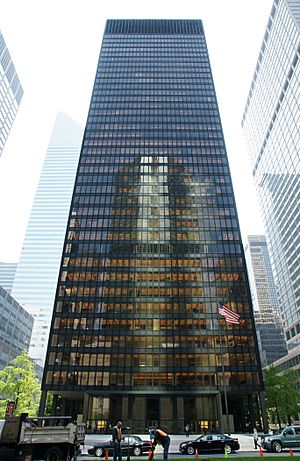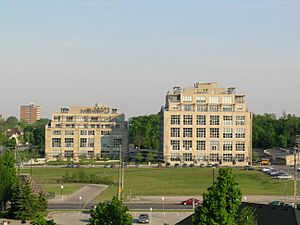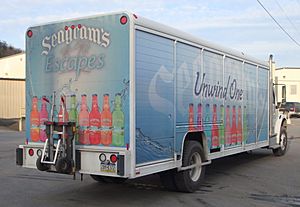Seagram facts for kids
 |
|
|
Trade name
|
Seagram's |
|---|---|
| Industry | Beverages |
| Fate | Seagram's core business was broken up and acquired by Pernod Ricard, Infinium Spirits and Diageo; entertainment assets sold to Vivendi; |
| Successors | Vivendi Pernod Ricard Infinium Spirits Diageo Universal Studios Universal Music Group NBCUniversal Comcast |
| Founded | 1857, in Waterloo, Ontario, Canada |
| Defunct | 2000 |
| Headquarters |
,
Canada
|
|
Number of locations
|
Burlington Oakville Oshawa Brampton Saskatoon Edmonton Burnaby Waterloo |
|
Key people
|
Joseph E. Seagram Bronfman family |
| Products | Alcoholic beverages, Ginger ale, Tonic water, Club soda |
The Seagram Company Ltd. was a large Canadian company that used to make and sell drinks. It was known by its trade name, Seagram's. The company started in Waterloo, Ontario, Canada, making Canadian whisky. In the 1990s, it was the biggest owner of alcoholic drink brands in the world.
Later, Seagram also owned entertainment businesses. It bought MCA Inc., which included Universal Studios and its theme parks. To pay for this, Seagram sold its shares in a chemical company called DuPont.
Eventually, Seagram's drink businesses were sold to other big companies like Diageo and Pernod Ricard. Its entertainment parts, like Universal, were sold to a French company called Vivendi in 2000.
Contents
The Story of Seagram
How Seagram Started
The company began in 1857 as Waterloo Distillery in Waterloo, Ontario. In 1869, Joseph E. Seagram became a partner. By 1883, he owned the company completely, and it was renamed Joseph E. Seagram & Sons.
Many years later, in 1924, Samuel Bronfman and his brothers started Distillers Corporation Limited in Montreal. Their business grew a lot in the 1920s. This was partly because of Prohibition in the United States. During Prohibition, it was illegal to make or sell alcohol in the U.S.
In 1923, the Bronfmans bought a distillery in the United States. They moved it piece by piece to LaSalle, Quebec, in Canada. From Canada, they shipped alcohol to a French island near Canada called Saint Pierre and Miquelon. From there, people who illegally sold alcohol (called bootleggers) would take it to the U.S.
Growth After Prohibition
In 1928, the Distillers Corporation bought Joseph E. Seagram & Sons. The combined company kept the Seagram name. Joseph E. Seagram had passed away in 1919.
When Prohibition ended in 1933, Seagram was ready. They had lots of aged whiskies to sell to the American market, and the company did very well. In the 1930s, Seagram paid a fine to the U.S. government for taxes on alcohol shipped during Prohibition.
After Samuel Bronfman died in 1971, his son, Edgar M. Bronfman, became the head of the company. In 1994, Edgar M. Bronfman's son, Edgar Bronfman Jr., took over as CEO.
From the 1950s, Samuel Bronfman's four children owned most of Distillers-Seagram through their company, Cemp Investments. Some of Seagram's most popular drinks were Seven Crown, VO, and Crown Royal.
In 1981, Seagram had a lot of money and wanted to own different types of businesses. They tried to buy an American oil and gas company called Conoco Inc.. Seagram bought a large part of Conoco. However, another company, DuPont, stepped in and bought Conoco instead. In exchange for its shares in Conoco, Seagram became a big owner of DuPont. By 1995, Seagram was DuPont's largest single shareholder.
In 1986, Seagram started famous TV ads for its Golden wine coolers. With actor Bruce Willis in the ads, Seagram quickly became the top seller among drink companies.
In 1987, Seagram bought a French cognac maker called Martell & Cie for $1.2 billion.
Moving into Entertainment
In 1995, Edgar Bronfman Jr. wanted Seagram to get into the film and electronic media business. Seagram sold its shares in DuPont for $9 billion. Many people criticized this decision because the DuPont shares made up a big part of Seagram's earnings.
Bronfman used the money from the DuPont sale to buy a major part of MCA Inc.. MCA owned Universal Pictures and its theme parks. Later, Seagram also bought music companies like PolyGram and Deutsche Grammophon.
The End of Seagram
In 2000, Edgar Bronfman Jr. sold Seagram's entertainment business to Vivendi. The drink business was sold to Pernod Ricard and Diageo. By then, Seagram had about 250 different drink brands.
Today, some Seagram's brands are made by other companies. For example, Pernod Ricard licenses the production of Seagram's Cooler Escapes.
In 2006, Pernod Ricard planned to close a former Seagram distillery in Lawrenceburg, Indiana. But the distillery was sold instead. It is now called MGP of Indiana and still makes parts of Seagram's Seven Crown, which is now owned by Diageo.
In 2013, Charles Bronfman, Edgar Jr.'s uncle, said that the decisions leading to the sale of Seagram were "a disaster" for the family.
In 2018, Diageo sold some Seagram's brands, like Seagram's VO, to Sazerac. However, Diageo kept the Seven Crown brand.
Seagram's Lasting Impact

The Seagram name is still used today for several well-known drinks.
- Seagram's Seven Crown, used in the "7 and 7" cocktail, is made by Diageo.
- Seagram's V.O. is made by Sazerac.
- Seagram's Escapes coolers are made by Genesee Brewing for the U.S. market.
- Seagram Island Time coolers are made by Waterloo Brewing for Canada.
Seagram's House, the company's old main office in Montreal, was given to McGill University in 2002. It is now called Martlet House.
The famous Seagram Building in New York City was once the company's American headquarters. It was designed by famous architects Ludwig Mies van der Rohe and Philip Johnson. This building is known as an important example of modern architecture. When it was finished in 1958, it was the most expensive skyscraper in the world. The Bronfman family sold the building in 1979.
The Seagram Museum, which was in the original Seagram distillery in Waterloo, Ontario, closed in 1997. The building is now home to the Centre for International Governance Innovation and Shopify. Two old barrel storage buildings are now apartments called Seagram Lofts. New buildings, like the Balsillie School of International Affairs, were also built on the land.
See also
 In Spanish: Seagram para niños
In Spanish: Seagram para niños



